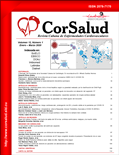Torsades de pointes in a patient with congenital long QT syndrome during the puerperium: Case report
Abstract
Congenital long QT syndrome is a primary electrical disorder of the heart which predisposes to the occurrence of malignant ventricular arrhythmias. It is characterized by a prolongation of the QT interval on the electrocardiogram and the torsade de pointes is the main associated arrhythmia, resulting in syncope and sudden cardiac death. Pregnancy and puerperium increase the incidence of those events. We present the case of a patient who suffered from this disorder, and during the post-delivery period, she had events of faint and anxiety interpreted as psychogenic. Torsades de pointes without response to the available antiarrhythmic drugs was documented and she was transferred to the reference center (Instituto de Cardiología y Cirugía Cardiovascular), where the pacemaker stimulation frequency was increased and, subsequently, an implantable cardioverter defibrillator was implanted. This is an infrequent case that was a real challenge for the comprehensive and emergent treatment, all of which enabled the survival of the patient.Downloads
References
1. Zayas Molina R. Actualización sobre el síndrome de QT largo congénito. Rev Cuban Invest Bioméd [Internet]. 2012 [citado 30 Abr 2019];31(2):129-44. Disponible en: http://scielo.sld.cu/pdf/ibi/v31n2/ibi01212.pdf
2. Mizusawa Y, Horie M, Wilde AA. Genetic and clinical advances in congenital long QT syndrome. Circ J. 2014;78(12):2827-33.
3. Jervell A, Lange-Nielsen F. Congenital deaf-mutism, functional heart disease with prolongation of the Q-T interval and sudden death. Am Heart J. 1957;54(1):59-68.
4. Romano C, Gemme G, Pongiglione R. Rare cardiac arrythmias of the pediatric age. II. Syncopal attacks due to paroxysmal ventricular fibrillation. (Presentation of 1st case in Italian pediatric literature. Clin Pediatr (Bologna). 1963;45:656-83.
5. Ward OC. A new familial cardiac syndrome in children. J Ir Med Assoc. 1964;54:103-6.
6. Nakano Y, Shimizu W. Genetics of long-QT syndrome. J Hum Genet. 2016;61(1):51-5.
7. Medeiros-Domingo A, Iturralde-Torres P, Ackerman MJ. Clínica y genética en el síndrome de QT largo. Rev Esp Cardiol. 2007;60(7):739-52.
8. Pérez-Riera AR, Barbosa-Barros R, Daminello Raimundo R, da Costa de Rezende Barbosa MP, Esposito Sorpreso IC, de Abreu LC. The congenital long QT syndrome Type 3: An update. Indian Pacing Electrophysiol J. 2018;18(1):25-35.
9. Rashba EJ, Zareba W, Moss AJ, Hall WJ, Robinson J, Locati EH, et al. Influence of pregnancy on the risk for cardiac events in patients with hereditary long QT syndrome. LQTS Investigators. Circulation. 1998;97(5):451-6.
10. Barcelos AM, Teixeira MA, Maia Mda C, Camanho LE, Assumpção OQ. Síndrome de QT largo y torsades de pointes postparto. Arq Bras Cardiol [Internet]. 2009 [citado 3 May 2019];93(4):e46-47. Disponible en: http://www.scielo.br/pdf/abc/v93n4/es_22.pdf
11. Gallardo Y, Puga MV, Román PA, Pérez JE, Vasallo R, Guerra BM. Síndrome de QT largo y embarazo. Experiencia en Cuba. Rev Cuban Cardiol [Internet]. 2018 [citado 3 May 2019];24(2). Disponible en: http://www.revcardiologia.sld.cu/index.php/revcardiologia/article/view/751/pdf_128
12. Ishibashi K, Aiba T, Kamiya C, Miyazaki A, Sakaguchi H, Wada M, et al. Arrhythmia risk and β-blocker therapy in pregnant women with long QT syndrome. Heart. 2017;103(17):1374-9.
13. Schwartz PJ, Dagradi F, Castelletti S. Evolution in managing long QT syndrome: From registries to centers of excellence. J Am Coll Cardiol. 2017;70(4):463-5.
14. Wilde AA, Moss AJ, Kaufman ES, Shimizu W, Peterson DR, Benhorin J, et al. Clinical aspects of type 3 Long-QT Syndrome: An International Multicenter Study. Circulation. 2016;134(12):872-82.
15. Thottathil P, Acharya J, Moss AJ, Jons C, McNitt S, Goldenberg I, et al. Risk of cardiac events in patients with asthma and long-QT syndrome treated with β2-agonists. Am J Cardiol. 2008;102(7):871-4.
16. Mathias A, Moss AJ, Lopes CM, Barsheshet A, McNitt S, Zareba W, et al. Prognostic implications of mutation-specific QTc standard deviation in congenital long QT syndrome. Heart Rhythm. 2013;10(5):720-5.
17. Priori SG, Blomström-Lundqvist C, Mazzanti A, Blom N, Borggrefe M, Camm J, et al. Guía ESC 2015 sobre el tratamiento de pacientes con arritmias ventriculares y prevención de la muerte súbita cardiaca. Rev Esp Cardiol. 2016;69(2):176.e1-e77.
Downloads
Published
How to Cite
Issue
Section
License
Authors who publish with this journal agree to the following terms:- Authors retain copyright and grant the journal right of first publication with the work simultaneously licensed under a Creative Commons Attribution License that allows others to share the work with an acknowledgement of the work's authorship and initial publication in this journal.
- Authors are able to enter into separate, additional contractual arrangements for the non-exclusive distribution of the journal's published version of the work (e.g., post it to an institutional repository or publish it in a book), with an acknowledgement of its initial publication in this journal.










